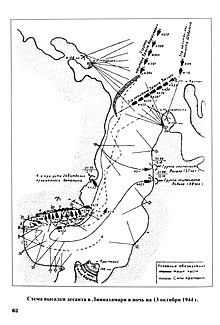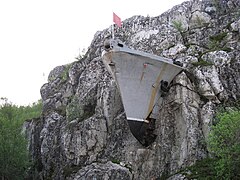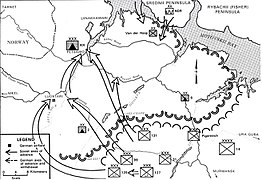Amphibious operation at Liinahamari
The amphibious operation at Liinahamari (Russian: Liinakhamari, Swedish: Linhammar, Finnish: Liinahamari) from October 12-14, 1944 was a Soviet tactical naval landing during the German-Soviet War , carried out by the Northern Fleet during the Petsamo-Kirkenes -Operation was carried out in the rear of the German positions.
Planning and preparation
The port of Liinahamari, near the city of Petsamo , was the main base for the export of nickel from the local finds to Germany and one of the most important naval bases on the Barents Sea . This base played a major role in the fight against the Soviet Northern Fleet and the Arctic convoys of the Allies . Therefore, the port of Liinahamari in the Petschengafjord (Petsamovuono) was transformed into a powerful defense field by the German Wehrmacht . The narrow and deep water access to the fjord was surrounded by high rocky coasts, at the entrance of which the Germans built a three-layer defense line and a five-layer defense line in the depths of the bay for artillery and machine-gun operations. The distance from the entrance of the fjord to the port was about 18 miles (33 kilometers). In general, the defense system consisted of the Bay of Liinahamari 4 coastal batteries of 150- and 210-mm cannons and 20 batteries of 88 mm - air guns , which were aligned for bombardment on soil and sea targets. The most powerful position was a battery with four 150-millimeter cannons at Cape Cross (Ristiniemi), which kept the entire Gulf between Petsamovuono and the port of Liinahamari under control. Another 88 mm cannon battery was set up nearby, and there were additional reinforced concrete bunkers in the harbor and on the quays .
The aim of the operation was to confiscate the batteries at Cape Cross, which resulted in a night landing at Liinahamari. The amphibious landing was meticulously prepared. Particular attention was paid to the training of the commanders of the speedboats . Admiral Arseni Grigoryevich Golovko , the commander of the Northern Fleet, personally took over the general management of the operation and held special meetings with the leaders of the speedboats.
The operation
Storming of the batteries on the Cape of Cross
The company to capture the batteries at the Cape Cross led a reconnaissance group of the Northern Defense District (Commander: Major IP Bartschenko-Emeljanow) and the 181st Special Division of the Northern Fleet (Commander: Lieutenant WN Leonow) - a total of 195 men. Due to the continuous protection of the coast by the Germans, three Soviet torpedo boats were used in the Gulf of Punajnen-Lacht on the night of October 10th, a commando landed two dozen kilometers from the target and the march to the target started under a thorough cover-up.
After a brief battle on October 12, the 88 mm battery was taken by surprise by the 181st Special Division and nearly 20 soldiers were captured. The reconnaissance department of the Northern Fleet meanwhile held down the opposing 150 mm battery in an artillery duel. In this fire fight, Soviet boats landed during the ceasefire and were able to defeat the German battery until October 13; the surviving crew of the battery (around 90 men) capitulated. The total loss of the Soviet landing party was 53 dead and injured.
Breakthrough of the speedboats in the port
The breakthrough of the landed troops to the port began in the late evening of October 12th. The starting point of the department was the fishing peninsula (Russian: Poluostrow Rybatschi, Finnish: Kalastajansaarento). The landing force consisted of the 349th separate machine gun battalion under Major IA Timofeew, the 125th Marine Infantry Regiment and other volunteers from the naval ships with a total of about 660 men. A total of 14 speedboats took part in the attack: the first division with 2 torpedo boats under Lieutenant AO Schabalin formed a corridor protected by a smoke wall in front, within which the second division with 5 torpedo boats under Captain 2nd rank SG Korschunowitsch and the third division with 1 torpedo boat and 6 patrol boats under captain 3rd rank SD Sjusin followed.
The Germans recognized the approach of the enemy boats at a distance of 4 to 5 kilometers and immediately turned their headlights to the danger and opened fire. The Soviet boats tried to penetrate the fjord “to the fullest” and to subvert the enemy fire area under the protection of another smoke screen. Without reducing their speed, the boats crossed the fjord (later referred to as the so-called "death corridor") and stormed into the harbor. With heavy machine gun fire and mortar fire, the boats covered the landing of the naval troops at their target areas. Two boats had lost their orientation during this action and made their landing on the side of the plan posts, which is why these groups were not able to take part in the subsequent fighting. Between 11 p.m. and midnight on October 12, 552 men were landed. The bulk of the troops landed on the quays, some on the banks of the fjord, to attack the coastal batteries there.
Cleaning up the banks, taking Petsamo
After a tough night close combat, the port of Liinahamari was captured by the Soviets on the morning of October 13th. Some of the most important German defenses continued to offer stubborn resistance throughout October 13, attempting repeated counterattacks. In support of the landing force, extensive artillery of the Soviet fleet attacked from the Middle Peninsula, and the air forces also took part in the fight. The last German resistance could be broken by the evening. During the night of October 14th and the morning of the following day, the Northern Fleet and its ground forces were concentrated at Liinahamari. During that day, the main roads along the coast near the port were cleared of the enemy. On October 15th the city of Petsamo (Pechenga) was stormed.
consequences
The conquest of the port of Liinahamari robbed the German XIX. Mountain Corps of the possibility of evacuation by sea and was of great importance for the Soviets for the further advance of the troops and naval operations. The port became the main supply point for the army and the fleet was given an important base in the Varangerfjord .
The Soviet landing was carried out at a high level and was crowned with complete success. The surprise of the attack was so great that the German port commander could only send one message to Kirkenes : "Bolshevik boats are breaking into the port, I will evacuate quickly!" The Soviet losses amounted to 1 torpedo boat and 1 patrol boat damaged by artillery but were still able to make the landing and leave the port safely. The gunboat SKA-428 ran aground under enemy fire in the harbor, on the command of the commander the boat was abandoned and the crew took part in the landing.
Awards
A large number of the participants in the landing received awards and medals. Alexander Schabalin was awarded the title Hero of the Soviet Union for the second time , and the boat commanders SG Korschunowitsch and SD Sjusin received the title of Hero of the Soviet Union. Among the participants in the storming of the Cape Cross, the commanders Major Bartschenko-Emelyanov, Lieutenant VN Leonov, SM Agafonov and AP Pshenichny and Lieutenant Colonel IP Katorschni were awarded the title of Hero of the Soviet Union.






